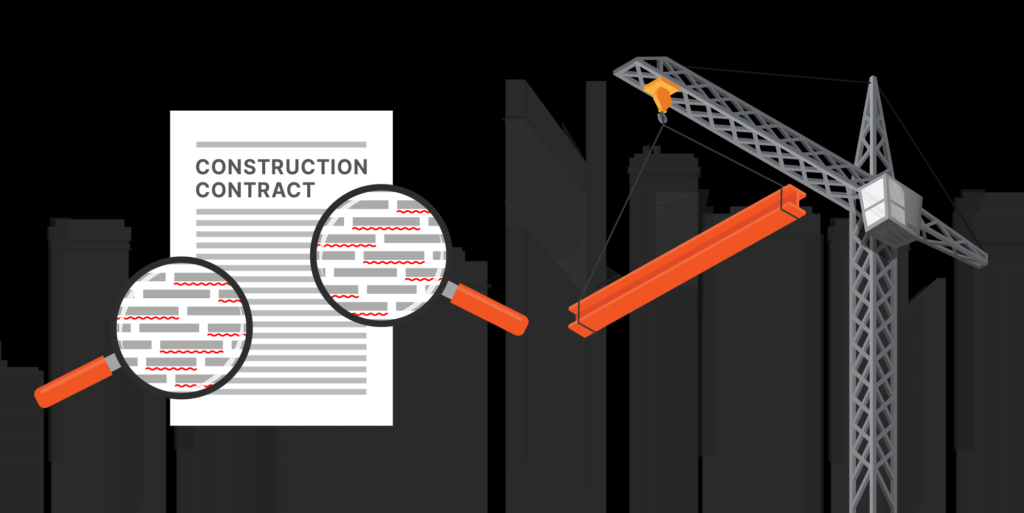— 7 min read
Contract Precedence: A Clause to Clear Construction Confusion


Last Updated Jun 11, 2024

Justin Vogel
Senior Solutions Engineer, Owners
Justin is a Senior Strategic Product Consultant for Procore. Justin has an extensive background in real estate development, construction engineering, and project management professional entrusted with high profile structures, and is involved in over $3.5 billion worth of construction representing developers, CEO's, GC's, equity partners, consultants, and attorneys in unique and complex pursuits.

Kacie Goff
Contributing Writer
91 articles
Kacie Goff is a construction writer who grew up in a construction family — her dad owned a concrete company. Over the last decade, she’s blended that experience with her writing expertise to create content for the Construction Progress Coalition, Newsweek, CNET, and others. She founded and runs her own agency, Jot Content, from her home in Ventura, California.
Last Updated Jun 11, 2024

Construction contracts are usually lengthy and complicated, composed of a wide range of documents In a perfect world, the contract provides the clarity and direction all stakeholders need to move forward on the project. Unfortunately, it’s not uncommon for contract documents to conflict with one another. For example, the drawing might specify one type of hardware for the doors, while the specs show another. And when contractors run into a conflict, how do they know which contract document to refer to?
Many contracts include a clause that lays out which documents take precedence, and in which order. This contract precedence clause provides clarity and serves as a useful tool if confusion arises. Let’s take a look at what contract precedence means: how it helps clear confusion, how precedence applies to different contract types — and alternatives to look at if dictating the order of precedence in construction contracts still leaves room for issues.
Table of contents
Setting the Precedent: Clarifying With This Clause
An order of precedence contract clause tells everyone involved in the project which documents supersede others. In some cases, the contract actually uses two clauses here. The first might simply state that contract precedence applies, while a sister clause lists out the order of precedence. In other contracts, these two clauses are combined into one.
Essentially, detailing the order of precedence in construction contracts provides a tie-breaker. If two pieces of information contained within the contract conflict, people can look to the contract precedence clause to point them toward which one to follow.
This way, if a dispute arises during a construction project because of contradictory or ambiguous information within the contract documents, all parties have clarity around which documents trump others. Ideally, this eliminates confusion and resolves any conflict.
Enumerating the contract document list in the precedence clause can deliver extra clarity. For example, the individual drawing up the clause might include the version number and date of the drawing package that takes precedence.
Contract Precedence Examples
To provide a clearer idea of the order of precedence in construction contracts, examples of precedence lists help. Here are a few contract precedence clause samples.
In federal government work, the Federal Acquisition Regulation (specifically, FAR 52.215-8) governs the order of precedence to which contract documents apply. It says, “Any inconsistency in this solicitation or contract shall be resolved by giving precedence in the following order."
- Representations and other instructions
- Contract clauses
- Other documents, exhibits, and attachments
- The specifications
The Nebraska Department of Economic Development provides a Sample Construction Contract Provisions document. It states, “In the event of conflicts, the documents shall control in the following order of precedence.”
- Contract with latest, Addenda, Amendments, or Change Orders
- Request for Proposal with latest Amendments
- Plans, Drawings and Specifications
- Contractor’s Proposal
Michigan State University has published a version of the ConsensusDocs 200 Standard Agreement and General Conditions Between Owner and Contractor (Lump Sum Price). Section 14.2.5, the order of precedence clause, reads, “In case of any inconsistency, conflict, or ambiguity among the Contract Documents, the documents shall govern in the following order.”
- Change Orders and written amendments to [this] Agreement
- Agreement and General Conditions
- Subject to subsection 14.2.2 the drawings (large scale governing over small scale), specifications and addenda issued prior to the execution of this Agreement or signed by both Parties
- Information furnished by the Owner pursuant to subsection 3.13.4 or designated as a Contract Document in section 14.1
- Other documents listed in this Agreement. Among categories of documents having the same order of precedence, the term or provision that includes the latest date shall control. Information identified in one Contract Document and not identified in another shall not be considered a conflict or inconsistency.
Clearly, there are several approaches companies can take when applying contract precedence. The key thing to note is that a good contract precedence clause breaks the tie between two documents with competing or confusing information.
Contract Precedence in Different Contract Types
Setting an order of precedence in construction contracts — or providing some other way to resolve conflicting information — is always important. But certain types of construction contracts make this especially critical.
Lump Sum
In a lump sum contract, for example, a single value gets affixed to the project. The owner wants to be certain that the work they expect can happen on that budget. At the same time, the general contractor (GC) and any subcontractors want to ensure they’re sufficiently compensated for their time and skills. As a result, all parties want to have a high level of clarity around the project to ensure the lump sum budget will work. A contract precedence clause plays a huge role here.
Time and Materials
In a time and materials (T&M) contract, on the other hand, answering questions might have less financial impact. While there should still be a path to resolve confusion, stakeholders are less likely to run into major conflict because GCs and subs can bill for their time and materials.
Guaranteed Maximum Price (GMP)
Guaranteed maximum price projects generally operate on the assumption that the GC knows how to do the work that’s required. With that foundation and the fact that the GC is responsible for absorbing costs above the GMP, owners may be less concerned with clarifying clauses like contract precedence.
Ultimately, though, any good construction contract builds in a way to clear up issues when they arise.
Benefits of Order of Precedence Contract Clauses
Adding a contract precedence clause delivers the following perks for all stakeholders:
Clarity
Guaranteed maximum price (GMP) projects generally operate on the assumption that the GC knows how to do the work that’s required. With that foundation and the fact that the GC is responsible for absorbing costs above the GMP, owners may be less concerned with clarifying clauses like contract precedence.
Increased Work Efficiency
When this clause exists, GCs and subs can refer to it when questions arise on the jobsite. Quickly learning that the specs take precedence over the drawings can point them to the right door hardware to install if the two documents conflict, for example. They can answer their question relatively rapidly and get back to work.
Fewer Requests for Information
Though requests for information (RFIs) are still useful if confusion persists, the contract precedence clause can clear up confusion, minimizing the number of RFIs on a project.
Peace of Mind for Owners
This clause allows project owners to determine what’s most important on the project and ensure compliance accordingly. They might give their request for proposal (RFP) precedence over the proposal the GC submitted, for example, to ensure that their desired project parameters hold weight if an issue comes up.
All of this said, not all projects use an order of precedence contract clause. That’s partially because some in the industry have moved away from this option to other ways to provide clarification.
Alternatives to Contract Precedence Clauses
Some leaders in the construction space, including the American Institute of Architects (AIA), now specifically advise against outlining order of precedence in construction contracts.
In Section 1.2.1 of its Guide for Supplementary Conditions, including Amendments to AIA Documents A201 and the Owner-Contractor Agreements, the AIA says, “In the event of inconsistencies among the Contract Documents, the Architect is to interpret them to reflect the design intent. Establishing a fixed order of priority is not recommended because no one document constitutes the best authority on all issues that may arise.”
When contract documents conflict, the stakeholder should move forward following whichever document lays out the highest standard specified in the contract. This clause hinges on clarity around which standard is higher, of course, so it’s not without its own issues.
Stay updated on what’s happening in construction.
Subscribe to Blueprint, Procore’s free construction newsletter, to get content from industry experts delivered straight to your inbox.

Contracts should provide a means to clarity.
Ultimately, the order of precedence contract clauses and other similar clauses — like higher standard clauses — aim to resolve conflicts before they even begin by providing the requisite level of clarity. When companies have the bandwidth to do so, they can take a further step here.
To avoid conflicts that arise from a lack of contract clarity, companies can designate a person or team to harmonize the contract. Because the contract often contains documents from various teams — from legal to procurement to technical — having one dedicated pass-through of all of those documents together can help to discover (and ideally rectify) conflicts.
The best construction projects are the ones on which everyone wins. Creating construction contracts that provide clear direction helps all stakeholders, from the owner to the sub who’s on the jobsite for just one day, to move forward on the same trajectory with the same goal in mind.
Was this article helpful?
Thank you for your submission.
80%
20%
You voted that this article was . Was this a mistake? If so, change your vote
Scroll less, learn more about construction.
Subscribe to The Blueprint, Procore’s construction newsletter, to get content from industry experts delivered straight to your inbox.
By clicking this button, you agree to our Privacy Notice and Terms of Service.
Thank you!
You’re signed up to receive The Blueprint newsletter from Procore. You can unsubscribe at any time.
Categories:
Written by

Justin Vogel
Senior Solutions Engineer, Owners | Procore
Justin is a Senior Strategic Product Consultant for Procore. Justin has an extensive background in real estate development, construction engineering, and project management professional entrusted with high profile structures, and is involved in over $3.5 billion worth of construction representing developers, CEO's, GC's, equity partners, consultants, and attorneys in unique and complex pursuits.
View profile
Kacie Goff
Contributing Writer | Procore Technologies
91 articles
Kacie Goff is a construction writer who grew up in a construction family — her dad owned a concrete company. Over the last decade, she’s blended that experience with her writing expertise to create content for the Construction Progress Coalition, Newsweek, CNET, and others. She founded and runs her own agency, Jot Content, from her home in Ventura, California.
View profileExplore more helpful resources

Using Standard Operating Procedures for Better Contract Management
Every construction project is different, meaning that GCs have to be continually agile and strategic about applying their experience. Major categories change from project to project, from the owner to...

Understanding Supplementary Conditions on Construction Contracts
No two construction projects are exactly alike — and the same goes for construction contracts. Even when using a standard contract form, owners and contractors sometimes use supplementary conditions to...

A Straightforward Guide to Construction Contract Review
Construction contracts are like the glue for the project team. They’re the ties that bind the working relationships and goals for the project, containing information about responsibilities, liabilities and processes...

Escalation Clauses in Construction Contracts: When and How They Apply
In construction contracts, an escalation clause allows for the escalation of a certain price for labor or materials to be used in a construction project. This type of clause is most...
Free Tools
Calculators
Use our calculators to estimate the cost of construction materials for your next project.
Templates
Find a template to help you with your construction project tasks.
Material Price Tracker
Get the latest U.S. retail prices and view historical trends for common building materials.
Glossary
Explore key terms and phrases used in the industry.
